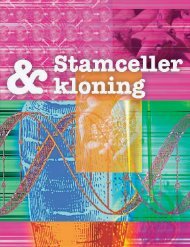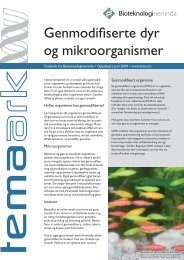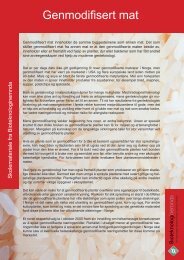Fiskevaksiner og genteknologi â Internseminar - Bioteknologinemnda
Fiskevaksiner og genteknologi â Internseminar - Bioteknologinemnda
Fiskevaksiner og genteknologi â Internseminar - Bioteknologinemnda
- No tags were found...
You also want an ePaper? Increase the reach of your titles
YUMPU automatically turns print PDFs into web optimized ePapers that Google loves.
Bioteknol<strong>og</strong>inemnda: <strong>Internseminar</strong> 5. september 2001other molecules are already there. How does itwork? If you look at a traditional killed or subunitvaccine, what you get is basically something calledinternalisation: When you have a typical cell withnucleus and endoplasmic reticulum, the cell takesinto itself the material of the killed bacteria, or of thesubunit components, i.e., ”dead” biol<strong>og</strong>ical material.It’s digested by lysosomal processes into fragments.You then get the development of an immunol<strong>og</strong>icalresponse based on this lysosomal system, in whichthe fragments are presented on the cell surface orexported, where it produces what is called a MHCII response, production of antibodies. It’s a specificresponse for doing that type of function.When one looks at live viruses, whether livepath<strong>og</strong>ens, attenuated viruses, or DNA vaccines, themechanism is somewhat different. DNA vaccinesstimulate another part of the immunol<strong>og</strong>icalresponse, where you get a vaccine plasmid insidethe nucleus of the cell. It produces a protein in thecell, which is then processed in the endoplasmicreticulum and transported to the cell surface, whereit is then presented as a MHC I system (as opposed totraditional vaccines, where you have MHC II), whichis a somewhat different immunol<strong>og</strong>ical response. Itwould be the same whether it is a virus or whetherit is a DNA vaccine - when the virus infects the cell,the cell makes the viral proteins and that produces animmunol<strong>og</strong>ical response.Administration of a DNA vaccineIn non-fish - cows, sheep, chickens, humans – theadministration is intramuscular (into the muscle),subcutaneous (under the skin), or in the mucus ornasal (nose spray, into the mouth). In fish, you alsohave intramuscular administration, intraperitoneal(into the peritoneal cavity) – that’s how one vaccinatesfish today: vaccinations today in fish goes into theperitoneal cavity, so the vaccine just washes aroundamongst the organs and gets absorbed from there– and immersion: you put the fish in a solution ofDNA vaccine where the fist would take the DNA up,generally through the gills, and of course swallowsome as well.Anatomy and production of a DNA vaccinevectorWhat does it look like? You have a circle of DNA.On that you have elements that one needs. The firstelement is what is called a replication origin, and thatis needed to allow the plasmid to grow in E. coli. Tomake a lot of this vaccine, you have to be able to growit and harvest it and the easiest place to grow it is inE. coli. So this element allows the plasmid to divideand replicate in an E. coli. The replication origin isspecific for bacteria, in fact only for a certain group ofbacteria. So, for example, that replication origin willnot allow it to grow in a eukaryote, for example a fish.Next, you have a gene for selection in E. coli. Generally,what is used today for experimental vaccines and inthe earliest stages of research, are antibiotic markers,antibiotics: ampicilin, kanamycin. Then you have thegene of interest, the gene that is going to produce theprotein that will give the immunol<strong>og</strong>ical response.And you have two controlling elements: a promoterwhich controls gene expression when it is in the cells,and another regulatory sequence at the end calledpolyA, which has to do with the stability of geneexpression. Both of these are eukaryotic specific, sothat in bacteria these genes will not function. So youhave basically a system where, in bacteria, you can getreplicates of the plasmid, you can select for it and youcan grow up large amounts and harvest it, but the genedoesn’t work. When you stick it into eukaryotes, the8
















